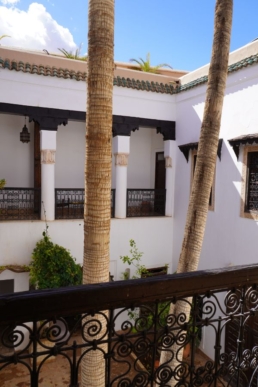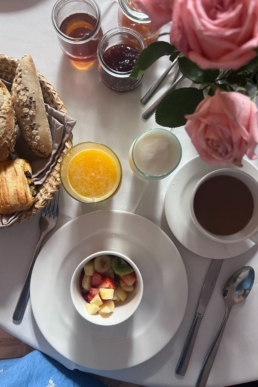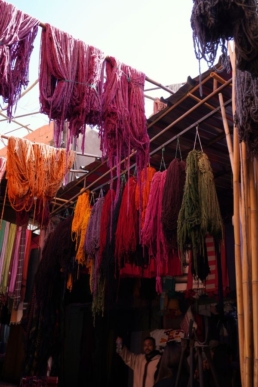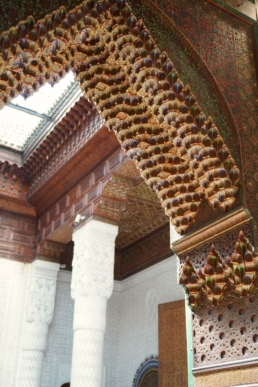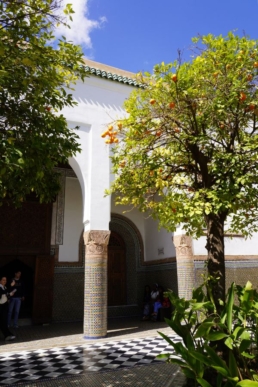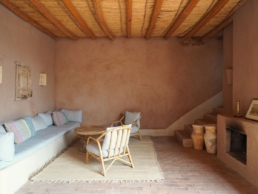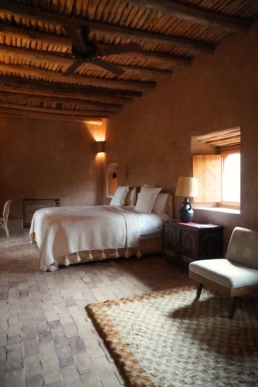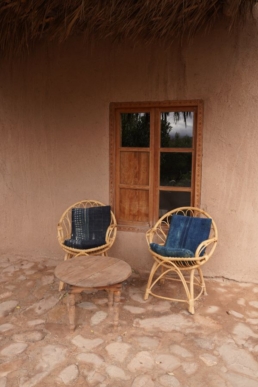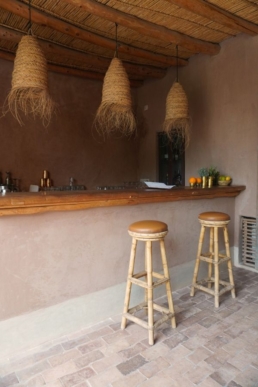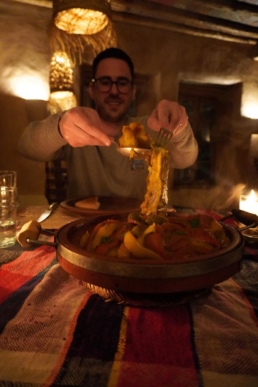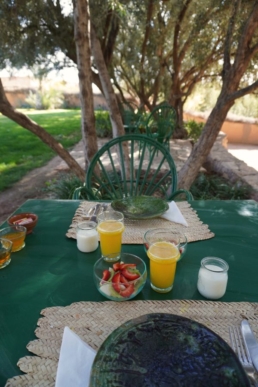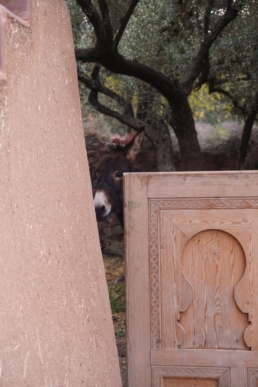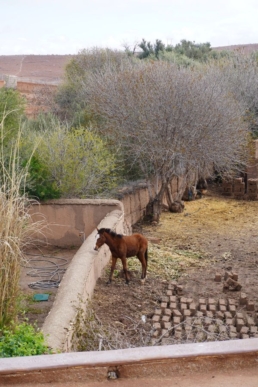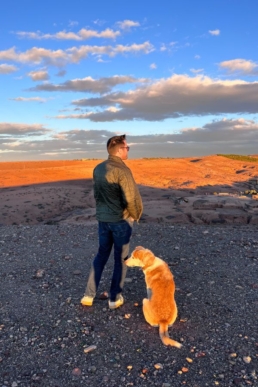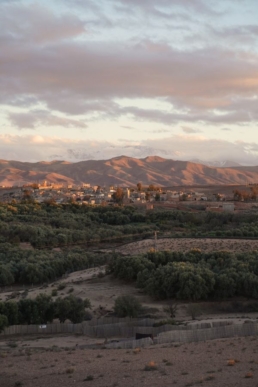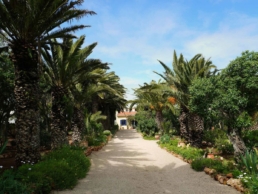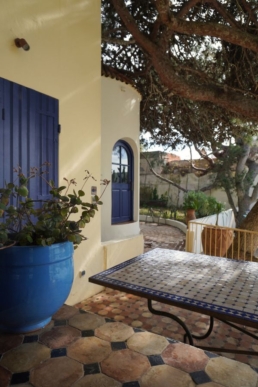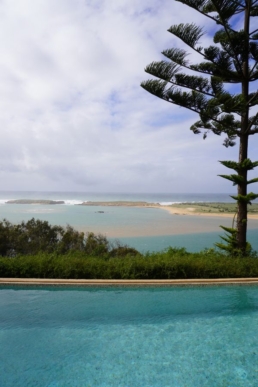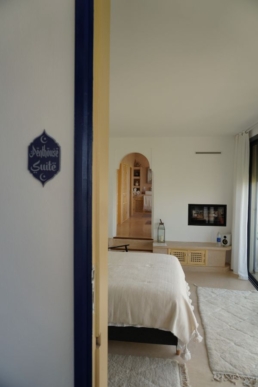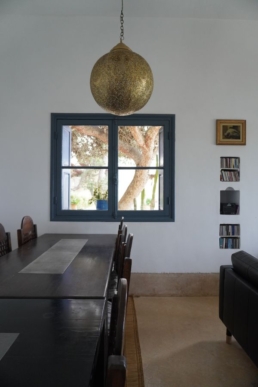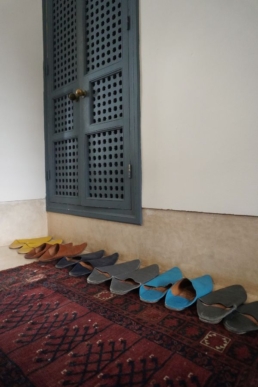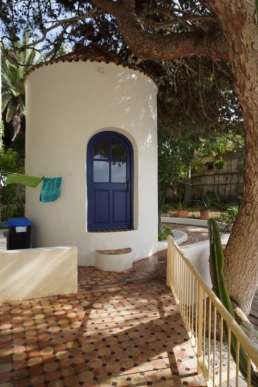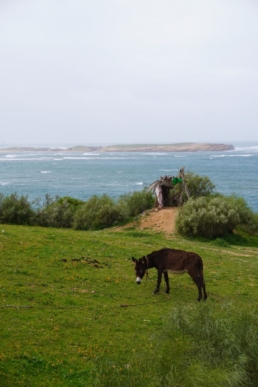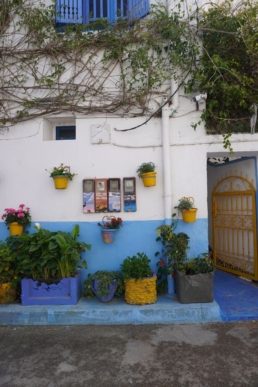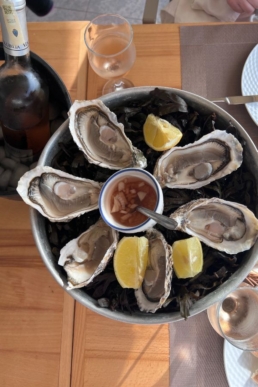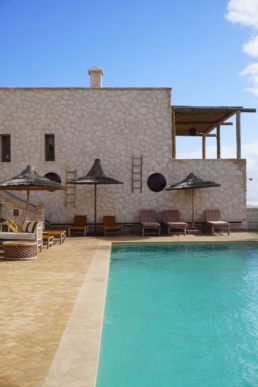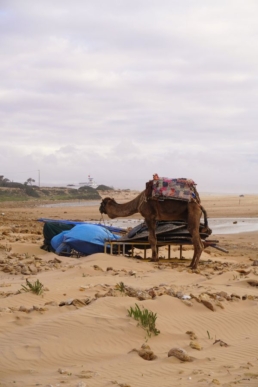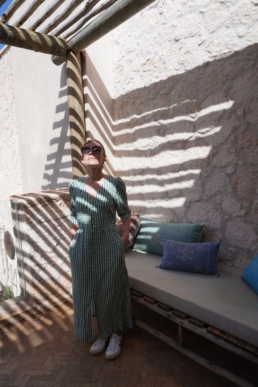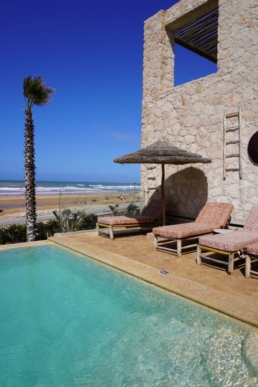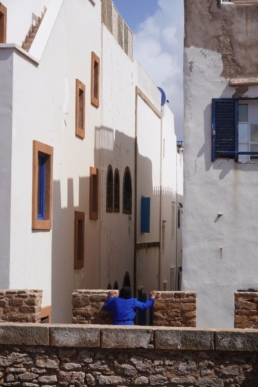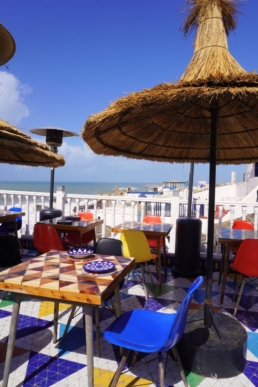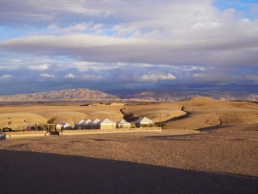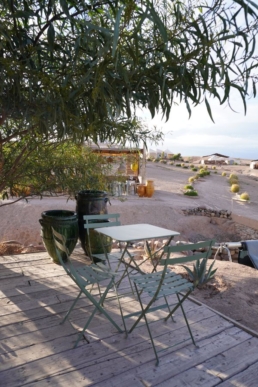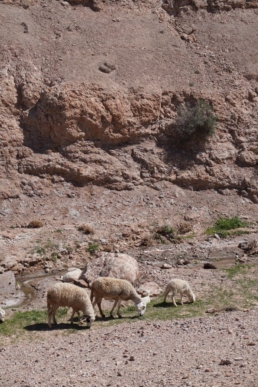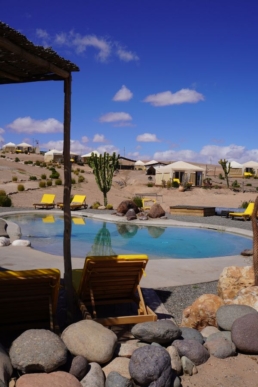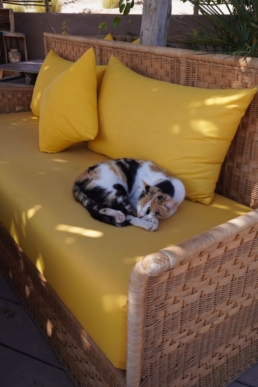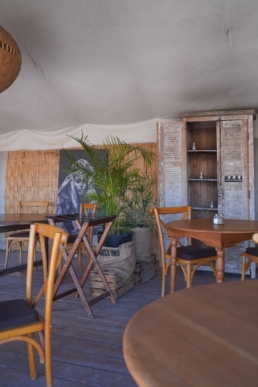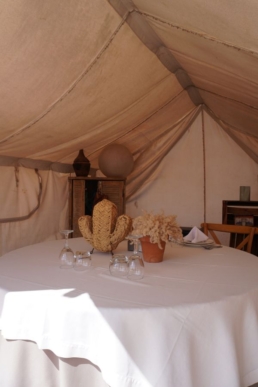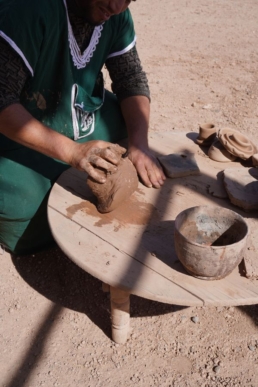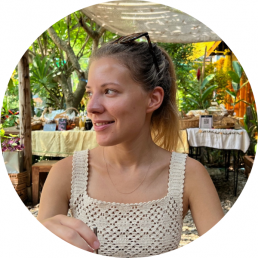
By Evelyn Chapman, Editor
For her first trip to Morocco, our Editor planned an epic 10-day tour from the souks of Marrakech to the dusty foothills of the Atlas Mountains to the windy Atlantic coast and back.
When you think of a Moroccan holiday, you probably picture tiled courtyards and colourful alleys; bustling souks and camel rides; parasols, palm trees, cool blue pools and (one would hope) lots of sunshine.
We had all that and more… minus the latter. I’d hoped to catch a glimpse of a different, quieter side of Morocco (which is why I chose to go in March, during Ramadan) and the universe responded with a record-breaking week of rain. So instead of sweating around a pool, we were gathered around fires and getting caught in downpours on blustery beach walks. But – hear me out – it was magical.
From Marrakech to the Atlas Mountain region, all the way out to the little-known coastal village of Oualidia, down to Essaouira, and a final stop in the Agafay desert. In ten days, in the most unexpected moments, we fell in love with a side of Morocco we never could have expected, and can’t wait to get back to (hopefully in slightly better weather).
JUMP TO: Marrakech | Atlas Mountains | Oualidia | Sidi Kaouki | Agafay
Days 1 & 2: Marrakech
Snakes poised at their handlers’ feet, women fanning themselves with their henna signs, donkeys pulling carts, juice vendors shouting, monkeys walking upright, tugged along on chains: we’d arrived in Jemaa el-Fnaa, Marrakech’s main square.
Our porter steamed ahead, his trolley cutting skillfully through the crowd, turning down a busy road lined with shops and crammed with people. Motorbikes and bicycles pushed through the centre, slow but determined, forcing us flat against glass displays of sticky sweets. The porter stopped and waited for us, smiling patiently as we awkwardly navigated the mayhem, before leading us down a side alley. Almost instantly, the noise and dust disappeared behind us as we rattled on through twists and turns, breathing a sigh of relief as we arrived at Riyad el Cadi’s ancient wooden door.
Where we stayed
Riyad El Cadi is a sprawling hotel made up of seven riads woven together by cool corridors and winding stairs. It was once home to Herwig Bartels, the German ambassador to Morocco, who bought and renovated the houses in keeping with the traditional 14th-century style to host his friends and growing collection of Islamic arts. The hotel is currently run by his daughter, Julia, but much is unchanged. The main courtyard, filled with orange trees and hung with lanterns, is a calming reprieve from the surrounding souks, and eye-catching artwork and ancient Berber artefacts are hidden down every hall.
We were led up to a Junior Suite, with a sunlit balcony overlooking one of the hotel’s six courtyards. With 17 rooms and suites, you would think there would be some hubbub in the common areas, but the tranquillity permeates everything. Only the songbirds seem immune to the sedative spell this place casts.
Exploring the city
Like veins winding through the medina, Marrakech’s souks pulse with the city’s unique energy. Navigating this labyrinth of shops and stalls can be tricky, but there’s no real harm in getting lost here, as long as you keep your wits about you. And there are too many beautiful things to see to be head-down in a map: spools of vibrant yarns, glimmering brass, woven baskets, piles of spices, painted ceramics, colourful rugs. If you do stop to shop, make sure to haggle – the starting price is often at least three times what it’s worth.
We accidentally found ourselves outside of Madrasa Ben Youssef, and the queue was surprisingly short, so we took the opportunity to check off our first site. Built as a religious school in the 14th century, this building is a celebration of history, art, restoration and craftsmanship. Though the grand courtyard gets the most attention (and is stunning), its scholarly and spiritual past lingers in the hushed, echoing quiet of the small student rooms and hidden courtyards.
The next day, after a generous breakfast served under the orange trees in Riyad El Cadi’s courtyard, we set off early. I’m embarrassed to admit that I waited too long to book Jardin Majorelle, so we trudged off to Le Jardin Secret instead. Dar El Bacha Museum wasn’t far, so we made our way there next. Many come here now just to get in the queue (usually around an hour) for the oh-so-Instagrammable Bacha Coffee, but it’s worth a visit for the artwork, the intricate carvings and ornate columns lining the leafy, sunlit courtyard. We carried on to Almoravid Koubba, the oldest building in Marrakech, before heading out of the winding labyrinth toward Kutubiyya mosque, with a stop for a leisurely lunch at a rooftop bar along the way.
As the sun dipped lower, we climbed up to Riyad El Cadi’s rooftop to watch the sunset. It was surprisingly blustery, so we had the entire terrace to ourselves as the calls to prayer rose up and drifted through the brisk, evening air. And though we’d planned to stay in, the sound of the city rustling to life after a day of fasting was too enticing, and we rushed out in search of cocktails and live music.
Days 3 & 4: Atlas Mountains
After two dizzying nights in Marrakech, we were ready to experience a slower, quieter side of Morocco, so off we went to the foothills of the Atlas Mountains. As the city disappeared behind us, the gravelly desert rose into hills fringed by Argan trees and adobe villages. And just thirty minutes later, we were turning down a bumpy, unpaved road through the little village of Oumnass.
Where we stayed
The weather had just turned as we arrived at Berber Lodge; the skies drizzly and morose, but the earthy walls, amber lighting and serene atmosphere within were the perfect refuge. We were warmly welcomed, given a brief tour, and brought a pot of mint tea before being shown to our room.
The rooms and suites are spacious and effortlessly stylish, a testament to the owner Romain Michel Meniere, a French-Swiss interior designer who has called Morocco home since 2002. Each adobe hut is inspired by traditional Berber architecture, made with local materials, and decorated with a mix of local craftsmanship and Moroccan antiques. It feels both plush and monastic – the perfect place for reflection and relaxation – with a bed so sumptuous you never want to leave. But there was lunch to be had, and a scrub booked in at their new onsite hammam and spa.
Later that afternoon, feeling rubbed raw and baby soft, we ventured to the lounge, where two seats sat empty and waiting by the fire. We sank down with our books and stayed for hours, revelling in the peaceful din: friendly chatter, fire crackling, cocktail shaker. With the wind lashing outside, a cat curled at your feet, and a negroni in hand, it’s hard to imagine you’re at a hotel and not in the house of an old friend who’s given you the keys for the weekend.
This feeling continues into dinner, where a set menu revolves around what’s in the garden or fresh from the market. These seasonal ingredients are whipped up into delicious feasts, mainly Moroccan and Mediterranean (though we had a surprise potato dauphinoise one night that put all others to shame). Though there are separate tables and communing with guests isn’t forced, there’s a friendly, collective spirit that means you can feel comfortable doing as much or as little socialising as you’d like.
The next morning, we were greeted by sunshine at last. Breakfast was a generous spread of bread, jams and honey, roti canai and your choice of eggs (done to perfection) served alongside strong coffee and fresh orange juice. After we’d happily scarfed it all down, we wandered through the leafy garden, said hello to the resident horse and donkey, and read by the pool for a while, enjoying the cool, wet, spring-like air. Before we knew it, it was time to prepare for our trip out to The Capaldi.
Rolling up the drive to the grand, intricately carved wooden doors of The Capaldi Hotel & Spa, you know you’re in for a treat. Through the reception and out into the grounds, you’re met by a long blue pool framed by palm trees, with plush loungers on either side, separated by thick hedges for privacy. Behind it all, the shadowy Atlas Mountains rise up, their snowy caps disappearing into the clouds. We were greeted by the manager, Carole, who moved from the UK to Morocco several years ago and hasn’t looked back. She was also fasting for Ramadan, but from her cheery, upbeat energy, you’d never have guessed it. As we toured the grounds with her, she greeted every guest we passed by name and teased her staff good-naturedly about football. There is not one, but two pools here, plus an expansive yet intimate restaurant and bar, and a range of beautiful rooms, suites and villas. It feels vast compared to Berber Lodge, but the warm familiarity of the staff and the cosy intimacy of the spaces throughout give it a home-away-from-home feel. We sat for lunch at a table between a crackling fire and the pool – a fat, juicy lamb burger for him, chicken cous cous for me – and Carole recommended a glass of Moroccan Gris that made basking in the afternoon sun even more heavenly.
That evening, back at Berber Lodge, we took one of the paths from the parking area up to a viewpoint for sunset. Joined by a couple of sweet canine guides, we reached the blustery top just in time for the sun to run through the lavender clouds and drench the hills in golden light. We stayed until our faces were red and wind-burnt, then trotted back down for another night curled up in front of the fire with a book and a pot of mint tea.
Days 5 & 6: Oualidia
The next morning was bright and warm, so we had our last breakfast at Berber Lodge out in the garden before setting off on the three and a half hour drive to Oualidia. Passing through villages, small cities, long stretches of farmland and scrubby desert, rain showers and tumbling clouds and blinding sunshine, until finally, a sliver of sea emerged on the horizon.
In July and August, Oualidia is said to be abuzz with Marrakshis on holiday, but in March it’s sleepy and peaceful; the landscape lush and green. And it has that salty, bohemian flavour that’s so universally characteristic of coastal towns. But I hadn’t prepared myself for the sheer drama of the sweeping views across the bay – uncapturable in photos – like stepping into a classical painting.
Where we stayed
Looking down the green, leafy tunnel towards the little yellow house at the end of the drive, with its blue shutters and terracotta roof, you’d think you’d been transported to the French countryside. But step inside and the typical Moroccan archways, Berber rugs, a colourful row of leather slippers and, of course, the view of the sea through the French doors, bring you back to the windy North African coast.
This is Villa la Diouana: our home for two nights. It’s a spacious family cottage with three bedrooms and a Penthouse Suite above. There’s also the Garden Suite and the Palm Suite with separate entrances just steps from the villa’s front door. It’s the perfect rental for a large family, group of friends or multi-generational trip, with a children’s play area and paddling pool, a pretty garden, lounge, cosy library, and an infinity pool looking out across the lagoon. But for this visit, it was just the two of us – sleeping in the Penthouse Suite, with the villa to ourselves.
The property manager, Abdillah, lives nearby and checks in daily to give cheerful recommendations and help organise whatever you need. His wife Fatima prepares the meals and does the daily cleaning, always full of sweet smiles.
Exploring Oualidia
Being here in the off-season, most of the restaurants were closed, and the streets were quiet (with the exception of a lively crowd gathered around a pickup football match nearby). And because the weather was so bad, there were no boat trips or beach picnics to look forward to.
Each day we went out for a wander along the coast, were caught in a downpour, and ended up in the same empty restaurant on the beach which – despite its tired facade – served up delicious fresh seafood just steps from the water’s edge. And there were worse places to be stuck. While the rain pattered against the glass, we feasted on Oualidia’s famous fresh oysters and cold glasses of local wine. Then, we’d make our way back, following a sandy path along the lagoon, as a misty sunset stretched out between the grey sea and the lavender clouds above.
When we returned to the villa, damp and cold, a huge tagine would be waiting for us, with salads, fresh bread and dessert, all courtesy of Fatima – ready to enjoy at our leisure. All to say, this place is blissful whatever the weather (though I would recommend flying into Casablanca and staying longer, if possible).
Days 7 & 8: Sidi Kaouki
On the road again, this time along the coast to Sidi Kaouki, a beach village just south of Essaouira. This stretch of coast feels different – more rugged, arid, open and flat compared to Oualidia’s rambling green cliffside. The road running along the beach is lined with bohemian cafes, camels, surfboards, motorbikes and a few aging hippies with wild hair and salt-washed tans.
Where we stayed
Kasbah d’Eau is a new boutique hotel looking out at Sidi Kaouki’s wide sandy beach, with a bright and airy restaurant and bar, a large atrium, and a stunning infinity pool surrounded by sun loungers. Inside, bold colours and eye-catching artwork fill the high walls down to the colourful tiled floors. We stayed in the Amina Suite, with a spacious terrace overlooking the pool and the beach beyond. It was so comfortably furnished and impeccably designed, we found it difficult to leave.
But we knew we only had a short window of clear skies, so we rushed out for a quick kip in a sunlounger before the clouds rolled in again. By this time, we had become accustomed to evenings indoors and got cosied up in the atrium with our books. As a smoky orange line reached across the horizon and the sea turned a pale, frothy blue, we watched a string of horses canter along the water’s edge, silhouetted against the sea, their tails and wild manes whipping in the wind.
Day trip to Essaouira
Known as the ‘Wind City of Africa’, Essaouira is a charming, laid-back coastal city nestled behind weather-beaten ramparts. While it still draws in tourists and windsurfers, it’s far less chaotic and crowded than the Marrakech medina.
We stopped for lunch at a casual little place tucked away down an alley called FISHBURGER. They’re famous for their sardine and fried fish burgers, and after many, many tagines, we were eager to branch out. The sardine burger was huge, deliciously salty without being too pungent, packed with umami and dripping in sauce. The fried fish was flaky with perfectly crispy batter on a fluffy, slightly sweet bun.
Where shopping in Marrakech had felt overwhelming at times, here it was a treat. Prices were lower and are even sometimes displayed, which made haggling less stressful. And the vendors we met were relaxed and sincere. Unfortunately, we didn’t have much room left in our bags, but we came away with some beautiful ceramic mugs of varying crackled colours.
Before we left, we climbed up to Salut Maroc’s rooftop bar and enjoyed a drink in the gusty sunshine, with a view over the ramparts and the waves.
Back at Kasbah d’Eau, we slipped into our robes and padded down to their beautiful spa for a hammam and massage. If you haven’t experienced this before: you’re told to strip down and lie out on a hot stone slab in a dark, steamy room. Then you’re vigorously scrubbed down to your last layer of skin and washed over with buckets of warm water. At first, I found the no-nonsense nature of it slightly uncomfortable and a little jarring; it made me feel like a child at bathtime. But afterwards, you feel brand new. And if you add a massage on afterwards, you feel entirely reborn. It’s no wonder this ancient Roman practice has become a ritual before prayer here in Morocco.
Days 9 & 10: Agafay
Since we were flying out of Marrakech late on the Sunday, it made sense to stay somewhere closer to the city, so why not make the most of it in a desert camp? This isn’t rolling golden sand dunes – it’s a stony, otherworldly landscape – but it’s still a unique experience just thirty minutes outside the city.
Where we stayed
Inara Camp is down a long road cutting through the desert, past several other luxury camps, camel farms and ATV rental sites. But once you arrive, you feel wrapped in the seclusion of endless grey, gravelly hills again.
The camp has a cluster of nineteen luxury tents, each with a shower, ensuite toilet, heating and air con, comfortable beds and a deck with sun loungers. Paths lead down from each towards a small pool, a communal campfire circle and their restaurant – spread between tents and outdoor seating. Here, you’ll find that the staff, all dressed in robes and turbans, are warm and accommodating and the food always delicious.
When we first arrived, it was bitterly cold and windy, so we stuck to the heated tents. But the next day, our last day, the sun came out in full force. We went up to the camp’s pottery studio for an impromptu workshop with a smiling local man, then beelined for the infinity pool overlooking the camp. It was still too brisk for a swim to be appealing, but the sun was heavenly, and we lapped it up until it was time for our taxi to whisk us away.
Morocco in March
Despite being very unlucky with the weather, I would definitely recommend Morocco in the off-season. I had expected a whirl of colour and smells and spices and instead was met with quiet alleyways, serene green landscapes and empty beaches. For someone who enjoys slower, gentler travel (and doesn’t mind some rain) it was ideal. But if you’re a sun worshipper looking for a bit of excitement, I’d come in April or May instead.
But I certainly wouldn’t avoid Ramadan. Visiting Morocco during Ramadan gave a unique look into the country’s cultures and spirituality, and also meant that the medinas were quiet during the day. It was one of the many things that made this trip so special.

